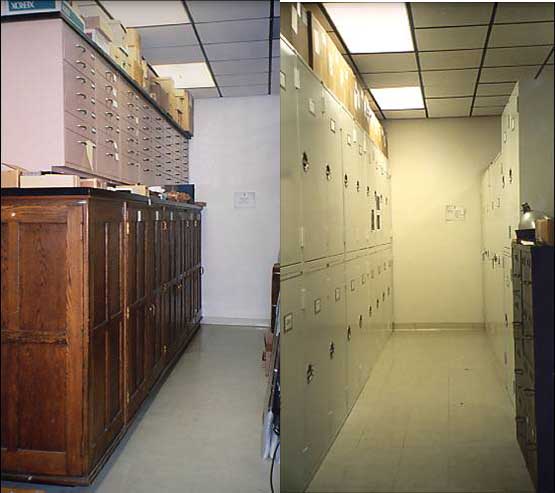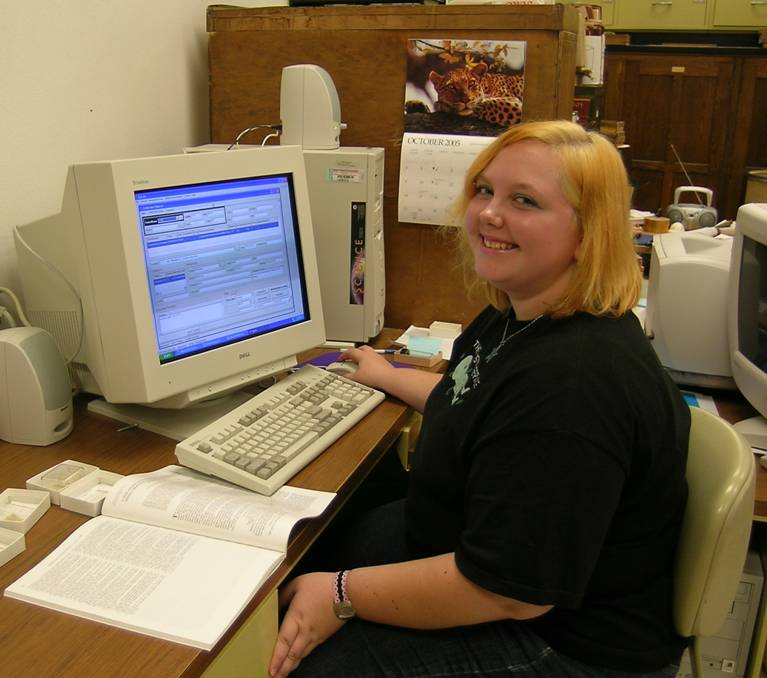Project Summary
The University of Iowa Paleontology Repository has been ranked among the top ten collections in North America in terms of size and significance, and supports the research activities of a paleontology graduate program recently ranked seventh in the nation. The Repository contains some 25,000 type and referred specimens and over one million specimens in total. It has long been the primary holding facility for paleontological and geological collections in the state, and is the focal point of the research and teaching activities of the paleontology faculty in the Department of Geoscience. Faculty retirements and increasing pressure for space, mitigated by designation of a storage facility, require urgent, comprehensive reorganization of the satellite collections. The project: (1) undertook a complete evaluation of the holdings in order to assign material to on- or off-site storage; (2) completed a range of curatorial projects facilitating reorganization, including curation of retiring staff members� research collections and several special collections of potential interest to the community at large; (3) effected the physical reorganization, including purchase of new specimen cabinets; and (4) disseminated the results and increased collections access and usage via a greatly enhanced World-Wide Web presence and online specimen catalog. Funds were requested for salaries of additional personnel (a curatorial assistant and a graduate student research assistant), cabinets and computer equipment, curatorial supplies, visiting specialist costs, and moving expenses.

Before and after images of the cabinet installation.

Graduate student Holly Schultz organizes specimens in the new cabinets.

Undergraduate student Holly Berg enters type material information into the Specify database.
Final Report
Research and education activities of the project
The Repository Reorganization Project (phase I) has improved storage and curation standards of the collections, increased access for research through improved organization and internet accessibility to collections data, and allowed type collection curation to be brought up to date. Specifically, the project has accomplished the following:
• Improved storage allowing more efficient use of space. Forty-one Viking specimen cabinets were purchased and installed, replacing old wooden cabinets and small metal drawers that had no sealing gaskets and provided less protection against dust and environmental fluctuations. The replacement of the small metal drawers increased storage capacity in the same space. Type specimen storage was increased by 50% allowing for future accessioning of material to be published by Budd ( National Science Foundation Grant DEB-0343208 (3 yrs., 2/1/04-1/31/07, $192,147); "Collaborative research: Biogeographic isolation and morphological convergence in scleractinian corals: morphological and molecular analyses of members of the suborder Faviina"), and Adrain ( National Science Foundation Grant EAR-0308685, 8/01/2003-7/31/2006, $115,000; "Collaborative Research: Patterns of diversity and faunal turnover at a Late Cambrian trilobite extinction event: testing for phylogenetic, stratigraphic and environmental biases"), as well as material deposited by faculty from other institutions. Storage facilities were created for the research collections of Budd, Adrain, Brochu, Sims and their students.
• Expansion and renovation of additional space at satellite storage facilities. The Repository was allocated 738 sq. ft. additional storage space at satellite locations at Oakdale research park and Halsey Hall (main campus), and used grant funds for minor renovations and moving expenses. Collections stored in these facilities include new bulk acquisitions for sorting and accessioning (e.g. Strimple Bequest, 2002), and bulk samples and residues requiring long-term storage but less frequent access. The Halsey storage facility houses the paleobotany collection transferred from the Department of Biological Sciences in 2004.
• Reorganization of poorly organized collections, allowing inventory and easier access. Several collections were completely reorganized (brachiopods, Paleozoic corals, Neogene corals, bivalves, gastropods, comparative vertebrates, large Quaternary mammals). Specimens were organized by age, locality and species, deteriorated specimen boxes were replaced (13,000 new boxes were purchased), labels were cleaned and preserved, and an inventory of genera per locality, age and collector was created in a Microsoft Access database. Historic handwritten labels were scanned for future use on the Repository website.
• Inventory of collection with on-line access. The Microsoft Access database inventory of the collections, including genera, and basic stratigraphy and locality information, is available on-line at http://www.uiowa.edu/~geology/paleo/Specimen_Catalogs.html.
• Implementation and upgrading of Specify database. The Specify Biodiversity Collections Management relational database, designed by the Specify Software Laboratory at the Biodiversity Research Center, University of Kansas, was implemented for the Repository specimen catalogue. Data were migrated by Specify staff, and data entry forms, queries and reports for specimen labels were created and/or modified by the Assistant Curator.
• Updating of type catalogue, curation of type material. The Curator, Assistant Curator, and several graduate assistants entered a backlog of type specimen data into the Specify database (6,954 records from 319 publications and theses). Type specimens were incorporated into the type collection.
• Assessment of selected collections. Visiting specialists (travel expenses and stipend funded by grant) assessed several collections and made recommendations for curation (Graham Young, Paleozoic corals; Jed Day, Belanski collection; Jon Todd, Neogene mollusks; Kevin Cummings, non-marine mollusks; Colin Sumrall, Strimple collection). The assessments resulted in improved collection access, organization of collections, deaccessioning of uncatalogued material with no data, research or historical significance to teaching or outreach collections, updated identifications, interpretation of old labels, determination of unique or important specimens, and collection inventory.
• Development of Repository website and virtual exhibits. The Assistant Curator and several students developed the Repository website to include information about the collections, on-line access to searchable collections data, and virtual exhibits (Bison-aging Techniques, Jamie Toennies; The Barbados - Antigua Expedition, Lindsay James and Cynthia Simpson; the Shimek Photographic Collection, Georgia Millward).
• Prioritizing of collections for cataloguing and database entry. Reorganization and inventory of the collections allowed determination of curation priorities for Phase II of the Repository development (data development, data sharing, and an illustrated specimen catalogue). A Museum Studies undergraduate student, Mari Horton assisted with the development of the survey and assessed several units. Survey assessments were used to prioritize future curation projects. Tiffany Adrain presented a joint paper about collections surveys at the 2005 SPNHC conference (Adrain, Lewis and Horton, 2005), and a manuscript has been submitted for publication.
• Preparation of Repository archive. Shelving and archival storage boxes were purchased for the creation of Repository archive. Field notebooks, original manuscripts, photographs, historical correspondence, 19th century specimen catalogues, lantern slides, glass plate negatives, and personal artifacts pertaining to the history of the Repository and paleontology at the University of Iowa were collected together. A Museum Studies intern (Jill McCleary) produced guidelines and recommendations for the development of the Repository archive. Museum Studies intern Georgia Millward organized and supervised the transfer of the Bohumil Shimek lantern slide collection from the Department of Biological Sciences to the Repository. Geoscience undergraduate Holly Berg began the preservation of the Repository specimen card catalogue (archival photocopy backup stored off-site).
• Accession or storage of emeritus faculty collections and improved research study areas. Collections made by Klapper (conodonts), Semken (micromammals) Baker (comparative seeds), and Glenister (South Florida samples, Amoco collections from Florida) were incorporated into the Repository storage area. Study space was made available for emeritus faculty to work on their collections for research and curation. Jamie Toennies assisted Klapper with the curation of UI conodont thesis material and archival material.
Findings
The Repository Reorganization Project (Phase I) has improved research access to the collections in the following ways:
- Searchable specimen data is available on-line (via Specify database) for the Type Collection, Paleozoic ammonoid collection, biocommunities collections, Quaternary vertebrates, Paleozoic fish, comparative vertebrate collection, conodont thesis material, all new accessions (over 35,000 records in total).
- Collections inventory data is available on-line for most of the stratigraphic and taxonomic collections.
- Previously disorganized or disparate and inaccessible collections were reorganized and inventoried for easier access including trilobites, Neogene mollusks, Shimek Collection of non-marine mollusks, Paleozoic bivalve and gastropod collections, brachiopod, Paleozoic corals, and Quaternary large vertebrates. Material was sorted, organized, re-boxed, assessed, inventoried, and labels cleaned, scanned and preserved.
- Selected collections were assessed by visiting specialists (Neogene mollusks, Paleozoic corals, Belanski Collection, Strimple echinoderm collection) who made recommendations about the curation and future use of each collection.
- Improved preventive conservation was achieved by moving material into new cabinets. Bison material was removed from old wooden drawers to new metal cabinets lined with polyethylene foam, cleaned and organized. Oversized specimens were moved from open shelving and tops of cabinets to two new cabinets with slide-out shelves. Large comparative vertebrate material was cleaned and rehoused on open shelving with specially constructed dust covers. Collections were relocated to Repository facilities from temporary storage, e.g. the Belanski stratigraphic collection was unpacked from 1930s wooden kegs, Mazon Creek and Dakota Sandstone plant fossils were unpacked from cardboard boxes where they were wrapped in newspaper.
- Expansion space for large acquisitions, e.g. three cabinets of Pennsylvanian material collected from now inaccessible quarries in Iowa by Ph.D. student, John Pope; the paleobotany collection (>4,000 specimens) transferred from Biological Sciences in 2003, including previously uncatalogued type material and an important collection of coal ball and other material from the Pennsylvanian of the Midwest; the Christina Strimple Bequest of Midwest echinoderms (>1000 specimens).
HIGHLIGHTED for broken links:
Students were involved in a number of projects in addition to specimen curation including:
- Bison population study on-line exhibit and M.S. thesis- Toennies, J. L. Dows Holocene Fossil Bison Assemblage, Franklin County, Iowa: Its Application To Conservation, Interpretation, and Outreach, University of Iowa, Department of Geoscience, M.Sc. thesis, 2003.
- The Nutting Collection and Barbados-Antigua Expedition (online exhibit).
- The Shimek lantern slide collection (online exhibit).
- A. O Thomas, member of Barbados-Antigua Expedition, former student and faculty member (hallway exhibit).
- "Women in Geology: Snapshots in U of I history focusing on Repository archive material (hallway exhibit).
- Collection surveys- Adrain, T. S., Lewis, D. N. and Horton, M. M. 2005. Improving curation standards in paleontology collections- where to start? In Miller, C. G. and Davis, P. G. (eds), Society for the Preservation of Natural History Collections 20 th Annual Meeting and Workshops, abstracts and outline programme. The Natural History Museum, London, UK. June 2005, p. 23-24.
- "Fossil Focus: Crinoids" (on-line exhibit, in progress).